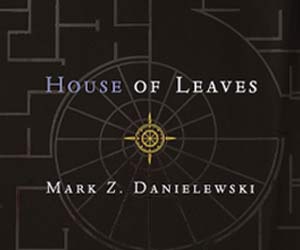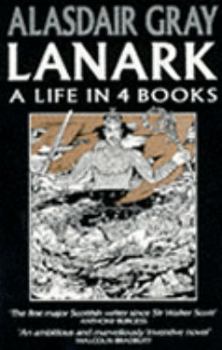Lanark a Life In 4 Books
Select Format
Select Condition 
Book Overview
40th anniversary edition'Probably the greatest novel of the century' Observer Lanark, a modern vision of hell set in the disintegrating cities of Unthank and Glasgow, tells the interwoven stories of... This description may be from another edition of this product.
Format:Paperback
Language:English
ISBN:0330319655
ISBN13:9780330319652
Release Date:January 1994
Publisher:Picador
Length:576 Pages
Weight:0.85 lbs.
Dimensions:7.8" x 1.5" x 5.1"
Customer Reviews
5 ratings
A True Modern Classic
Published by Thriftbooks.com User , 17 years ago
"Lanark" was first published in 1981, but its author spent 20 years writing it. And it's indeed a massive piece. The whole book is divided into four books (starting with book 3). I think it's one serious classic novel, sadly not as famous as it ought to be; but this here review will change that for the best. Of course. This novel is a bit of two stories in one. There's a "surreal" story and a more autobiographical "realist" story. If I was to go into details, this would quickly become very complicated. It's not exactly an easy read, but it's worth it. I don't even know how I am going to say anything about it without going crazy... The story begins in a world which at first seems fairly common, but quickly turns into something you're not familiar with. I won't say more on that, but it's a kind of hell, or afterlife of some sort. Within that frame, the second story occurs (or the first, since book 1 and 2 are the "realist" story and book 3 and 4 are the surreal world). The order of the books is: 3,1,2 and 4. I'm sure this sounds messy as hell but I promise it makes much more sense when you are into the book. Book 1 and 2 are very much autobiographical of Gray's life, though not an actual biography. In short, Duncan Thaw (the main character) is a young boy living in Glasgow and we follow him throughout his (short) life, and then in the afterlife world, hence the subtitle of the book "a life in four books." Duncan is a very talented boy and grows up to be an art student (Gray worked as an art teacher for a long time, and is a great painter himself, he did all the illustrations found in Lanark). I can't say enough those two books, I think I prefer them over the surreal ones but they're not quite comparable. As to book 3 and 4, I'll give you a tiny taste of it with the following stuff: the story begins in the city of Unthank, and it's a bit of an urban hell where the sun shines for a few minutes each day. That's where Lanark is, and he has no memories of his past. He wants sunshine and love. In that world, people "disappear," and that won't make sense till you're further into the novel. But I'll tell you what, people get strange diseases in this world, and these diseases reflect the problem with them. Eventually everyones is... can I even say that without sounding completely weird... everyone is swallowed by giant mouths into the "institute," which is a place much like hell, only it's an hospital where these people, who have "disappeared," are treated. I won't say more because it's important that you find out for yourself (and anyway summing this stuff up is just like talking about an acid trip). Gray is a really brilliant writer and his books 1 and 2 are stuff to be worshipped. Maybe I'll post selected bits later on in this thread. I really recommend this for anyone interested in something that will surely be looked upon as one of the best novels ever written in the universe (no less). It's already a big classic in contemporary literature,
Daunting to be the first
Published by Thriftbooks.com User , 21 years ago
I don't know if no one has reviewed this tome for fear of where angels tread lightly or what, but I have to say something about this amazing book, if for no other reason than to start a dialogue.I first heard of this book from a Village Voice article about the republication of "Lanark" in a four-volume set. The structure of this edition is that it begins with Book 3, followed by the Prologue, Book 1, Book 2, and Book 4 is divided by an Epilogue that takes place 4 chapters from the end. This convoluted structure actually makes the book rather fascinating, in that Gray has said that he wishes for the book to be remembered in a certain order, which is why he put "Book 3" first. This edition also features artworks by the artist at the front of each Book, and the Epilogue features some interesting typesetting. For readers of science fiction, this book will offer an interesting challenge, for books 1 and 2 are more a coming-of-age of the artist sort of affair. Books 3 and 4 center around the Lanark character, who is called Thaw in 1 and 2. The Thaw books reminded me many times of Maugham and Joyce, while 3 and 4 seemed positively Dickian. (Not to be confused with Dickensian, which slant-applies, if at all.) There's a lot of ferocious literariness going on in this book, yet there's all sorts of humor. And also a slice of life in a city I know absolutely nothing about. The depictions and commentary on Glasgow reveal a lot about the self-consciousness of 2nd-tier and below cities--the cities that are not New York, London, Florence, Paris, Moscow, etc. I found this a wise book, filled with difficult ideas and a morose feel for the future of mankind and the difficulties of being a solitary individual in the anomie-infested modern civilization. Book 4 I think is a fascinating attempt to turn Hobbes's Leviathan into a sentient being, as viewed by the hapless adventures of the eponymous hero. I will be thinking about this book for a long time.
Scotland Made Strange
Published by Thriftbooks.com User , 24 years ago
Twenty-five years in the making, Alasdair Gray's "Lanark" immediately announced itself as perhaps the 20th century's most significant piece of Scottish fiction. Published in 1980, it was the first novel to invest Glasgow -- an industrial city associated more with gritty urban realism than romance -- with a rich, mysterious literary language. Gray's narrative structure, a mixture of baroque architectural complexity and self-referential devices, has led a number of critics to suggest an affinity with postmodernism. There is truth in this, but more compelling are the essentially tragic stories that lie at the heart of the book. Duncan Thaw, a young, alienated Glasgow artist trying desperately to find love is juxtaposed with Lanark, a less neurotic "version" of Thaw who inhabits the strange, unstable realm of Unthank. It is Gray's painterly eye for detail and his unfailing accuracy in rendering delicate emotional states that make the novel so touching and compelling.
Not for everyone, but a modern classic.
Published by Thriftbooks.com User , 24 years ago
This book blew my mind. Complex, challenging, but with a whole lot to say about the pain of growing up. It taught me a lot about modern Scotland (lifestyle, attitude), and I figure Gray's fragmented fantasy style must have been a big influence on younger better known Scottish writers (to me anyway) like Iain Banks, A. L. Kennedy and Andrew Crumey who are similar to Gray in some respects. I guess you could call it postmodernism but to me it's simply beautiful writing, told from the heart. This book's not for everyone, but it's a modern classic and an unforgettable journey of the imagination.
The nearest thing to the Great Scottish Novel.
Published by Thriftbooks.com User , 26 years ago
Dos Passos - USA; Joyce - Ulysses; Perec - Life A Users Manual...each work a sprawling, eccentric and often critical study of the lives, loves, hopes and fears of the people in their country of origin and Gray's work attempts to do the same for Scotland. Published in 1981, he had spent the previous fifteen years working on this sprawling onamasticon which encompasses several literary genres - from Short Story to Novel - and which could be described as being fantasy, science-fiction, autobiography, literary criticism and social realism: but don't let that put you off! This work also manages to be compellingly readable and deeply engaging. Set in a decaying Glasgow (Scotland) at some unspecified time in the future, the book opens on Part Three, where Lanark - the 'hero' - is dragged through a hole in a cemetery wall into a mysterious netherworld - The Institute - where people turn into dragons and nothing is quite what it seems: he rescues a woman from the process of becoming a dragon; he is injured and put into a hospital... he falls into a deep sleep, where he dreams or possibly remembers Parts One and Two. These sections are among the most poignant and beautiful passages of writing about adolescence, describing our hero's relationship with his father and his progress through the Glasgow School of Art in the late 1950s and early 60's, writing comparable with Joyce's 'Portrait of the Artist' in its aposite use of language and image. Part Four returns us to the hospital, where Lanark has woken up and we continue his quest to leave The Institute and return to Glasgow with his new-found love. It wouldn't be fair to give away more than this, but Gray builds the plot by the skillful use of structure (hence the apparently 'wrong-ordering' of the parts), character, often using characters from Scottish history in modern guise, and such post-modern devices as layout, collapsing narratives (at one point, Lanark meets Gray himself) and plagiarisms, all of which are copiously referenced and documented, though the author himself denies the 'post-modern' label. "I don't know what postmodern is," he said in a recent interview "But people always call my books postmodern." Post-modern or not, Alasdair Gray's Lanark is a work of fiction which will appeal to Scotophiles, Ex-pat. Scots, Fantasy Fans, Science-Fiction buffs and anybody who enjoys the brilliance of eccentric experimental writing.
Lanark: A Life in Four Books Mentions in Our Blog

10 Delightfully Tricksy Stories
Published by Ashly Moore Sheldon • March 31, 2021
Do you like surprises? On the eve of April Fool's Day we feature ten tales that will make you ask, "What is even happening?!" Each of these stories—spanning a wide array of genres and styles—has a trick or two up its sleeve.




